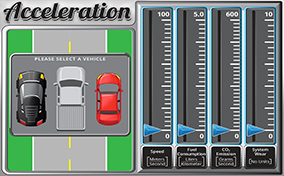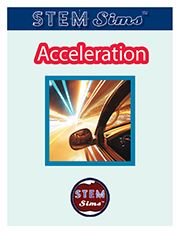Here are some definitions to help you in your investigation.
Average speed - how far something moves divided by the time it took to move
Carbon dioxide- a molecule of one atom of carbon bonded to two atoms of oxygen
Change in motion - speeding up, slowing down, or changing direction. This change in motion is also called acceleration.
Constant speed - not speeding up or slowing down
Consumption - amount of something used
Distance - how far something moves
Emissions - a substance released or given off
Force- any push or pull on an object that results in an interaction with another object
<line-break
Friction - a force that opposes the motion of an object
Interaction - a way one thing affects another thing
Speed - how fast something is moving
Time - how long something takes
Reading and Interpreting a Line Graph
What is a Line Graph?
A line graph is a tool that provides a picture using a line or lines to show how things change over time or how they're connected. For instance, you want to see how a plant grows over time. So you measure the plant's height every week. You can use a line graph to see how the plant is growing!
Reading and Interpreting the Graph (See Figure 1.)
• Seeing Changes: Look at the line. If it goes up, the plant is growing! If it stays flat, it's not changing its height, and if the line goes down, the plant is losing height.
• Comparing Weeks: You can easily see which weeks the plant grew the most by looking for the steepest parts of the line.
Finding the Height (See Figure 2.)
• To find the plant height at a certain week, find that Week Number on the bottom line (x-axis), go straight up to the line, and then look across to the Plant Height number on the side (y-axis). On this graph, the plant at week 6 had a height of 9 centimeters.
Extrapolating the Data Beyond the Line (See Figure 3.)
• Following the Trend: If the line is going up or down steadily, you can predict that the plant will continue changing its height at about the same rate in the next few weeks.
• Making a Prediction: You can extend the line a little bit past your last data point (see the dashed line) to make a prediction about the plant's height in the future. But remember, it's just a prediction! Things might change.
Using our extended line in this graph, we predict the plant will have a height of 7 centimeters at week 11.
• Limitations: Extrapolating too far out is not always accurate. The plant could stop growing, or grow at a different rate.
)
What are acceleration and speed?
Acceleration is the rate of change of velocity over time. Simply put, it is the rate at which an object speeds up or slows down. For example, if a car is standing still and the driver speeds up to 60 miles per hour (mph), the acceleration rate is how quickly the car reached 60 mph. Acceleration also works in the reverse, which is often referred to as deceleration. If the car slows to 20 mph, the deceleration rate is how long it takes the car to slow down. Note that this is different than speed, which is how quickly an object moves over a particular distance.
What factors impact fuel consumption?
Fuel consumption, or fuel economy, describes the relationship between how much fuel is used over a particular distance. In the US, this is most commonly expressed as miles per gallon (mpg). The higher the number, the more fuel efficient the vehicle. Many factors influence fuel consumption, including the mass, shape, and size of the vehicle. Other variables that impact fuel consumption include engine type and maintenance, tire inflation, driving habits, and road grading.
What factors impact carbon dioxide emissions?
Automobiles use a combustion engine, in which fuel is burned to provide energy to power the engine and move the car. If the fuel contains carbon, the greenhouse gas carbon dioxide (CO2) is released into the atmosphere as a byproduct of the combustion reaction. Fuel economy is the main factor in how much CO2 a vehicle emits, but fuel type is also a large factor. Different fuels contain varying levels of carbon; regular gasoline emits 19.4 pounds of CO2 per gallon of gasoline combusted, while diesel emits 22.2 pounds of CO2 per gallon, according to the US Environmental Protection Agency. Alternative fuels like ethanol and biodiesel give off less CO2 when burned, with estimates of 14.6 pounds per gallon and 5.84 pounds per gallon respectively.
What is system wear in an automobile?
The system wear of a vehicle is defined as how fast the parts deteriorate based on how they are used. Different aspects of driving wear out different parts of your car, and some systems wear out faster than others. Brakes, tires, and a host of other moving parts on a vehicle can wear out and require replacement.
What factors influence system wear?
The brakes are one example of a part of the car that deteriorates with use. Your driving habits have a great effect on brake wear. The brakes depend on friction to slow or stop the wheels, which wears out some of the brake pad, leading to system wear. If you drive aggressively so that you accelerate often and quickly and must brake often to compensate, you will wear out your brakes faster. Also, driving in stop-and-go traffic makes your brakes wear out faster since you apply your brakes more frequently than when driving on a highway. In addition to braking, accelerating also wears out your car. The faster you accelerate, the more energy you require from the engine, and the more stress you put on the drive system, which leads to greater wear.
How does a vehicle's shape impact its performance?
The shape of a vehicle has a great effect on its performance. A vehicle that is large and square, like a semi truck, encounters lots of air drag or friction due to the air striking the large, flat surface. This creates turbulence, which slows the vehicle down. Therefore, a non-streamlined shape would not perform as well as a small, sleek sports car. The large, flat vehicle would need more power to overcome the air drag and would be less fuel-efficient.
How does a vehicle's mass impact its performance?
The more mass a vehicle has, the more force is required to make it move. This is because a vehicle with a large mass has more inertia than a smaller vehicle. For example, a semi truck has much more mass than a sports car, and requires much more force, and subsequently more power from its engine to make it move a certain distance compared to what a small sports car would require to move the same distance.
 Does driving a car faster help save on gasoline since the time the engine is running is reduced? How does rapid starting and stopping of your vehicle impact the wear and tear on your vehicle's parts? How does the shape of a car affect how much carbon dioxide is released into the environment? Does the mass of a truck impact its fuel consumption? Should you clean out your car and only carry a minimum amount of stuff in your trunk? Your challenge is to answer these important questions using the tools provided in this module. By the way, for every 100 pounds of junk you carry in your car, your fuel efficiency is decreased by about 2%. That's like throwing away one dollar every time you fill up your car with gas.
Does driving a car faster help save on gasoline since the time the engine is running is reduced? How does rapid starting and stopping of your vehicle impact the wear and tear on your vehicle's parts? How does the shape of a car affect how much carbon dioxide is released into the environment? Does the mass of a truck impact its fuel consumption? Should you clean out your car and only carry a minimum amount of stuff in your trunk? Your challenge is to answer these important questions using the tools provided in this module. By the way, for every 100 pounds of junk you carry in your car, your fuel efficiency is decreased by about 2%. That's like throwing away one dollar every time you fill up your car with gas.)


